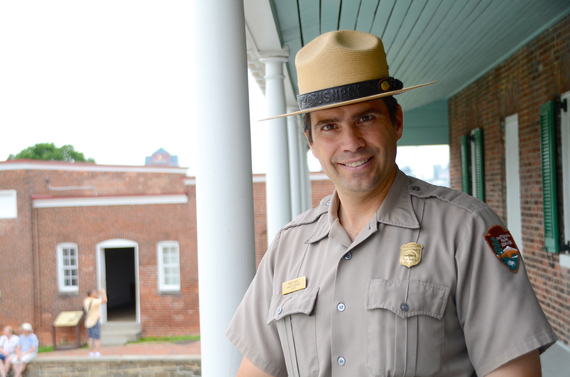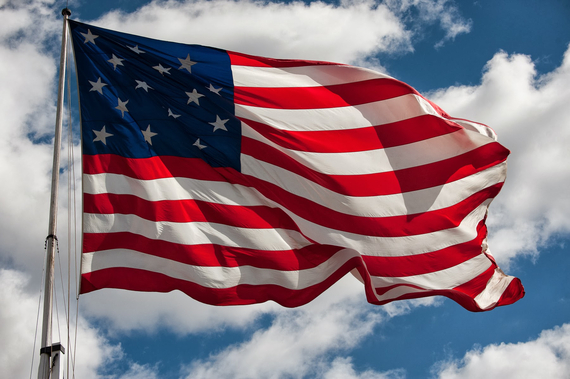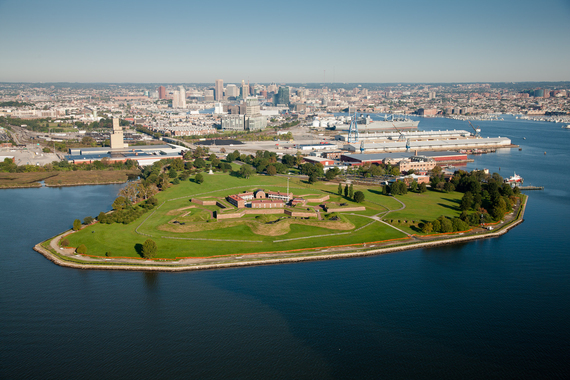Fort McHenry's Vince Vaise tells the behind-the-scenes story of the fort, the national anthem, Francis Scott Key and the War of 1812.
By Brooke Sabin for Where
The sight that inspired Francis Scott Key to pen what became the national anthem? A giant American flag above Baltimore's Fort McHenry on Sept. 14, 1814, signaling the city's rebuff of the mighty British navy during the War of 1812. In the run-up to the bicentennial celebration, we chatted with Fort McHenry's chief of interpretation, Vince Vaise. Since 1988 when his high school history teacher suggested he volunteer at the fort, Vaise has immersed himself in its facts and legends. And he eagerly shares his encyclopedic knowledge, whether he's in his NPS uniform or 19th-century military garb as leader of a dedicated band of re-enactors, the Fort McHenry Guard.

Do re-enactors audition for the job?
There's an interview, because of the unusual set of talents required: the ability to talk to visitors in an engaging way, do the marches and drills, handle a musket and be a historian.
Who trains them?
We do -- the National Park Service at Fort McHenry. And there are degrees of specialty, like the fife and drum corps. Those folks have to be accomplished musicians, too. We also have people who portray the civilians of Baltimore during the War of 1812.
Were there any women at the fort during the battle?
Washer women were here, and a few officers' wives, but not many. Major George Armistead knew the battle was coming and wanted to get the ladies out of the fort. But there are documents from the period saying the bombardment killed at least one woman.
What's a common misperception about the battle?
One is that the large flag flew all night. A "storm" flag flew overnight, but troops hoisted a bigger one the morning after the battle, and that's what Key saw.
Any surprising facts about Francis Scott Key?
He was an Anglophile who, at first, opposed the war. He would have watched Downton Abbey. He recognized that our language, of course, and a lot of our laws came from Great Britain. And even though he wrote "the land of the free," he was a slaveholder. He opposed slavery but was concerned about how freed slaves would support themselves. He represented the young, conflicted United States.
Who's the hero of the conflict?
There are, pun intended, "key" individuals. Major Armistead, the commander of the fort, had a big responsibility on his shoulders. Samuel Smith, a Maryland senator and leading businessman, was the general in charge of all Baltimore's defenses. A year and a half before the battle, he mobilized the business community to contribute funds to improve Fort McHenry, to pay ditch diggers to build entrenchments on the outskirts of the city. He used his political connections to bring ammunition, guns and militia to Baltimore. So even though no shells landed in his lap, he was the linchpin.
Do descendants of the defenders visit the fort?
Yes, we have a lot of friends in the General Society of the War of 1812 and the U.S. Daughters of 1812. They come here and help pay for the annual commemoration of the battle, which has been held every year since the war. I feel rather strongly about that. This year everybody wants to participate, because it's the bicentennial. But there's something to be said for the people who carried that torch in 1815 and 1920 and through the Great Depression. The societies recently bought two replica cannons for the fort. We've nicknamed them "The Son" and "The Daughter," and we'll shoot them.

You said that in a recent nationwide poll, only 23 percent of respondents associated Fort McHenry with "The Star-Spangled Banner." Why do you think that is?
The symbols -- the anthem and the flag -- took on a life of their own irrespective of the place. When you sing the national anthem, you don't have to know about Fort McHenry, but you get more out of it when you do.
Is the fort considered haunted?
There are stories. On one of the bastions that took a direct hit, people over the years claimed they saw two men dressed in War of 1812 attire. And that was before we had re-enactors here!
Fort McHenry is the only park service property that's a national monument and a historic shrine.
Yes, and people's perception of the park has evolved over the years. In the 1930s, '40s and '50s, Baltimoreans came here after church in their Sunday finery. Recreation was practically prohibited -- no picnicking, no playing. Then in the late 1960s, '70s and '80s, the ground around the fort opened for recreation. In the 1990s, visitors began to imagine themselves back in the day. They wanted to see people dressed in 1814-style clothing, to hear the fifes and drums, to walk into a barracks room and see it as it was then. For a lot of folks, the site is an oasis, but with what happened here, there's power of place. You feel that when you come.
What part of the bicentennial celebration are you looking forward to most?
On September 9, we're going to have 7,000 school kids create a gigantic American flag. Each student will don a red, white or blue poncho and be strategically positioned to form the flag. Then on September 14 at 9 am, we'll hoist the big hand-stitched replica flag, 200 years to the minute after Key saw the original. That's going to be awesome.
-----
More from Where®:
Photo credits: Courtesy Visit Baltimore, ©Brooke Sabin, Courtesy Maryland Historical Society
